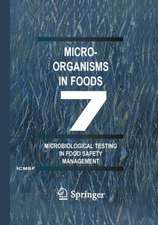Microbial Enzyme Technology in Food Applications: Food Biology Series
Editat de Ramesh C. Ray, Cristina M. Rosellen Limba Engleză Paperback – 31 mar 2021
The aim of food processing is to produce food that is palatable and tastes good, extend its shelf-life, increase the variety, and maintain the nutritional and healthcare quality of food. To achieve favorable processing conditions and for the safety of the food to be consumed, use of food grade microbial enzymes or microbes (being the natural biocatalysts) is imperative.
This book discusses the uses of enzymes in conventional and non-conventional food and beverage processing as well as in dairy processing, brewing, bakery and wine making. Apart from conventional uses, the development of bioprocessing tools and techniques have significantly expanded the potential for extensive application of enzymes such as in production of bioactive peptides, oligosaccharides and lipids, flavor and colorants. Some of these developments include extended use of the biocatalysts (as immobilized/encapsulated enzymes), microbes (both natural and genetically modified) as sources for bulk enzymes, solid state fermentation technology for enzyme production. Extremophiles and marine microorganisms are another source of food grade enzymes. The book throws light on potential applications of microbial enzymes to expand the base of food processing industries.
Din seria Food Biology Series
- 28%
 Preț: 371.12 lei
Preț: 371.12 lei - 12%
 Preț: 312.43 lei
Preț: 312.43 lei - 12%
 Preț: 315.26 lei
Preț: 315.26 lei - 25%
 Preț: 1049.50 lei
Preț: 1049.50 lei -
 Preț: 450.79 lei
Preț: 450.79 lei - 11%
 Preț: 318.59 lei
Preț: 318.59 lei - 11%
 Preț: 319.07 lei
Preț: 319.07 lei - 12%
 Preț: 315.00 lei
Preț: 315.00 lei - 15%
 Preț: 489.26 lei
Preț: 489.26 lei - 12%
 Preț: 339.73 lei
Preț: 339.73 lei -
 Preț: 493.12 lei
Preț: 493.12 lei - 12%
 Preț: 312.43 lei
Preț: 312.43 lei - 12%
 Preț: 312.43 lei
Preț: 312.43 lei - 12%
 Preț: 314.41 lei
Preț: 314.41 lei - 11%
 Preț: 319.07 lei
Preț: 319.07 lei - 15%
 Preț: 452.95 lei
Preț: 452.95 lei - 8%
 Preț: 390.86 lei
Preț: 390.86 lei - 18%
 Preț: 1389.36 lei
Preț: 1389.36 lei - 15%
 Preț: 703.38 lei
Preț: 703.38 lei - 25%
 Preț: 370.39 lei
Preț: 370.39 lei
Preț: 326.63 lei
Preț vechi: 363.80 lei
-10% Nou
62.51€ • 64.89$ • 52.12£
Carte tipărită la comandă
Livrare economică 22 martie-05 aprilie
Specificații
ISBN-10: 0367782561
Pagini: 520
Dimensiuni: 156 x 234 mm
Greutate: 1.13 kg
Ediția:1
Editura: CRC Press
Colecția CRC Press
Seria Food Biology Series
Locul publicării:Boca Raton, United States
Cuprins
Notă biografică
Descriere
The aim of food processing is to produce food that is palatable and tastes good, extend its shelf-life, increase the variety, and maintain the nutritional and healthcare quality of food. To achieve favorable processing conditions and for the safety of the food to be consumed, use of food grade microbial enzymes or microbes (being the natural biocatalysts) is imperative.
This book discusses the uses of enzymes in conventional and non-conventional food and beverage processing as well as in dairy processing, brewing, bakery and wine making. Apart from conventional uses, the development of bioprocessing tools and techniques have significantly expanded the potential for extensive application of enzymes such as in production of bioactive peptides, oligosaccharides and lipids, flavor and colorants. Some of these developments include extended use of the biocatalysts (as immobilized/encapsulated enzymes), microbes (both natural and genetically modified) as sources for bulk enzymes, solid state fermentation technology for enzyme production. Extremophiles and marine microorganisms are another source of food grade enzymes. The book throws light on potential applications of microbial enzymes to expand the base of food processing industries.






















